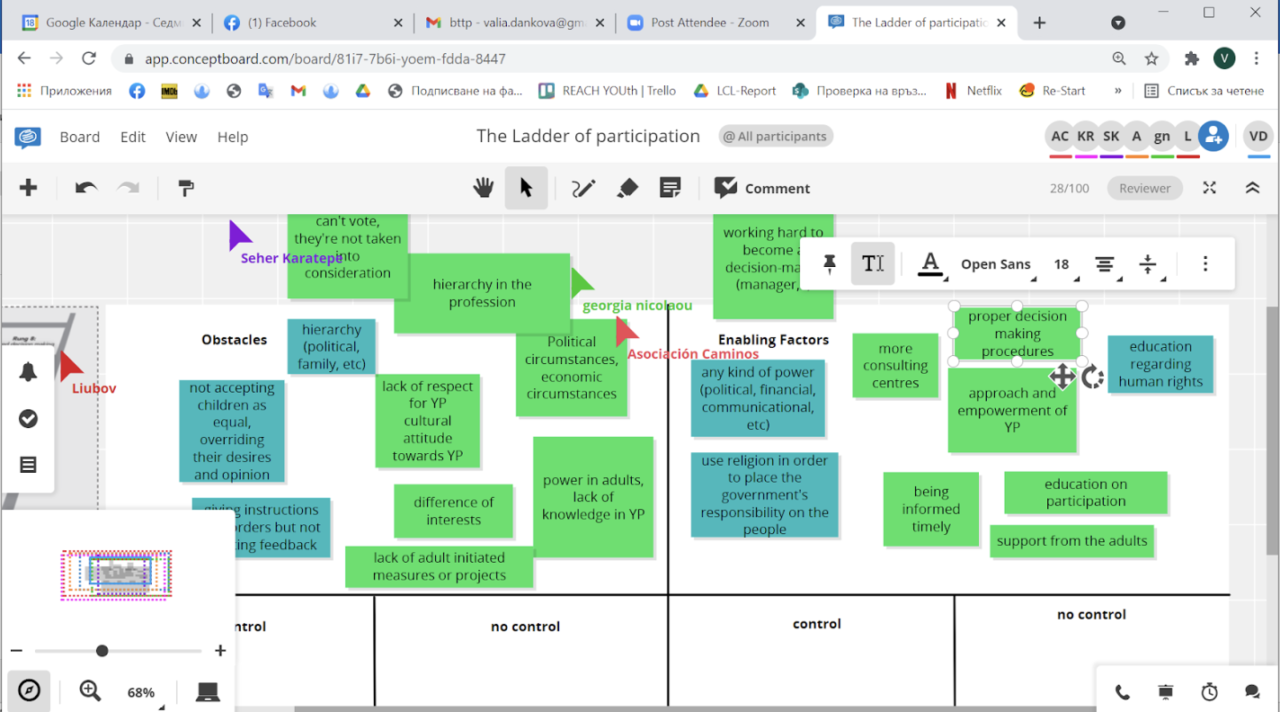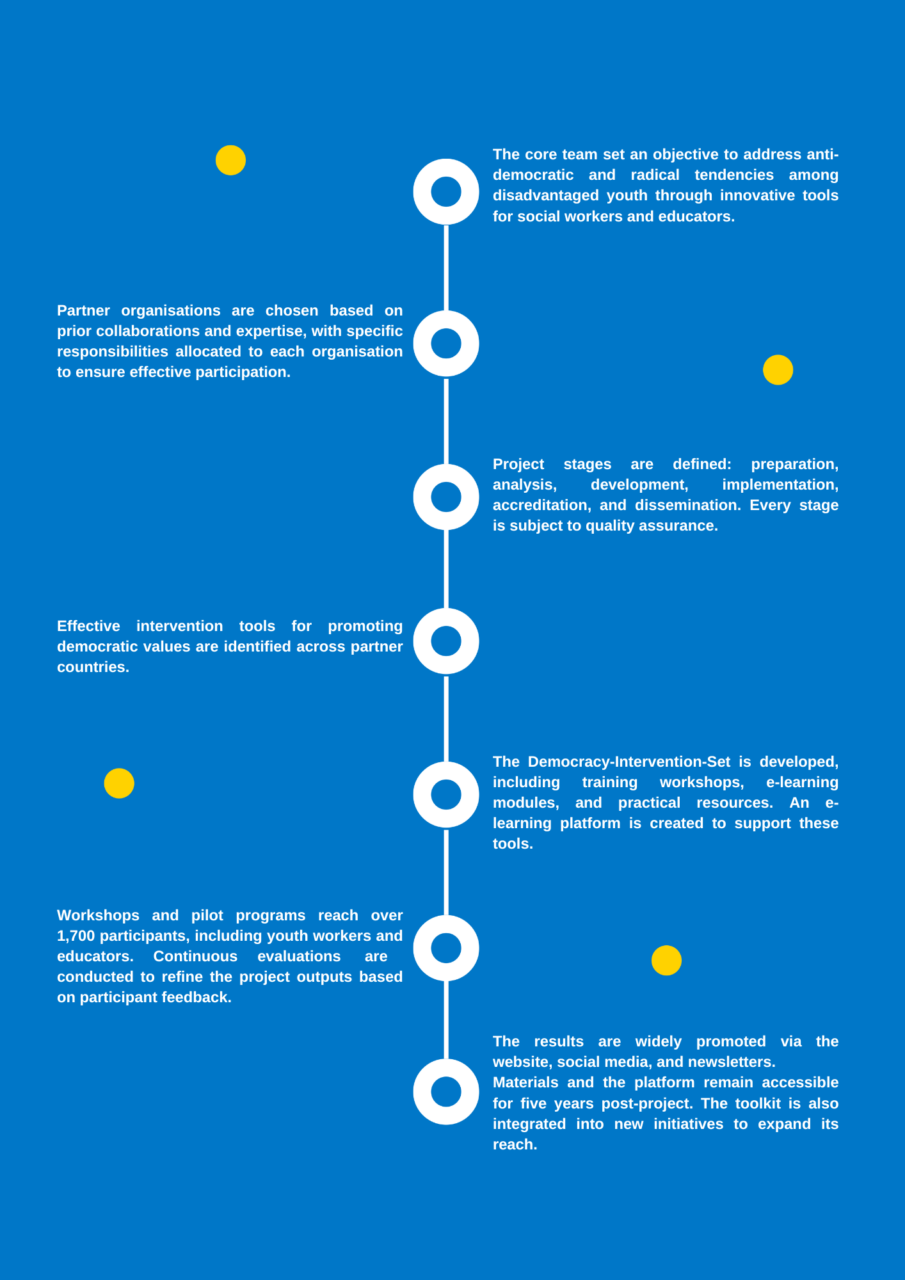A particular strength was the active involvement of youth workers and social work decision-makers, who brought a high level of expertise to the project. The results are user-friendly tools for professional development on the topic of democracy. These were created in such a way that further follow-up projects can build on them, and the thematic discussion in the EU countries can also be better supported. The entire project structure and its implementation are also exemplary for other topics, such as the understanding of inclusion.
A collaboration of organisations across five different countries, the Reach YOUth project addresses the growing influence of antidemocratic and radical tendencies among disadvantaged youth in Europe. The project developed a ‘Democracy-Intervention-Set’ of educational materials to teach youth social workers and teachers how to effectively promote democratic values and critical thinking among young people.
You need to be patient with each other and have fun. It’s not easy to communicate with the different English accents, so you should at least have a sense of humour. You need a real team spirit and must strive for added value rather than individual success when it comes to transnational cooperation. If one person cannot move forward or stumbles, the other person must help, even if it means more work for the helper. As the saying goes, one hand washes the other.
Seher Karatepe, project manager of REACH YOUth, joined us to talk about this initiative aimed at helping disadvantaged youth learn democratic values.
What was the principal goal of this project?
Youth social work has shown that disadvantaged young people tend to be influenced by anti-democratic groups and populist tendencies. If we want to encourage democratic thinking, it’s crucial to recognise and help these young adults as early as possible. Existing intervention options in Europe aren’t always effective enough for reaching disadvantaged youth. The project aimed to identify the most effective intervention tools across partner countries and bring them together in a ‘Democracy-Intervention-Set’ to support youth social work professionals in engaging young people with democratic values.
How did the planning for this project begin?
It started with an invitation from CAMINOS, a Spanish organisation, who asked if we were interested in this topic. We’d already successfully worked with them before, so we agreed. The kick-off meeting was in Vélez-Málaga, Spain, on 10–11 December 2019, and Reach YOUth began.
How did you break the organisation of the project into stages?
The project had clear stages: preparation, analysis, development, implementation, accreditation, and dissemination. Every stage was subject to quality assurance. Each partner had specific responsibilities and milestones, and we regularly monitored and reviewed activities to ensure compliance with our agreements. Internal evaluations were continuous, both quantitative and qualitative, reflecting each project stage. This management approach ensured quality in both processes and results.
Who was on your team, and how was it formed?
We already knew at least one partner from previous work. If that partner can also recommend others they trust, you build a strong team. Of course, we also brought on new organisations, but it’s important to research their experience beforehand. We highly recommend having one or two video calls before finalising the team to get a feel for communication and whether you share similar work standards.
How did you manage communication within the team and between the organisations?
We had monthly online meetings, and for urgent cases, we arranged extra appointments or communicated via email. It’s best to use simple communication tools like Skype, Zoom, and email. This allows project discussions to happen quickly. You also need patience, a sense of humour, and team spirit. Constructive communication is key, especially when addressing mistakes. If one person stumbles, others must be willing to help.
What were the challenges and benefits of working with partners from five different countries?
The difficulty in a multicultural team is that different working principles, standards, workflows, and working hours can clash. Different mentalities can sometimes conflict. But having very precise responsibilities and task allocations made our work much easier. Each organisation took on what it could implement best. Still, even the best plans had to remain open for adaptation, as it’s not always possible to implement each plan identically in every country.
The program includes training materials, modules, and an e-learning platform. How did you find authors to create these, and how did you unify them?
The partners were chosen because they already had experience in these areas. This basis, combined with consultations with the rest of the consortium, allowed each partner to use their skills to implement their work effectively. A good strategic plan, attentive partners, and always keeping the project’s overall goal in mind helped make everything work together smoothly.
How do you identify and engage stakeholders for the project?
Each partner held multiplier events to promote the project outputs and create connections with relevant stakeholders, such as socio-educational specialists, teachers/school authorities, political decision-makers in youth welfare, representatives of vocational training institutions and universities of applied sciences, NGOs, public youth welfare and employment promotion agencies, youth leisure facilities, etc. We reached out via mail, social media, and networks, with evaluation questionnaires provided at the end of events to gather participant feedback.


How do you recruit youth workers, social workers, psychologists, and teachers to participate? What motivates them to join?
The motivation was the actual need for the topic. These professionals are increasingly worried by radical tendencies, and many felt insecure dealing with young people affected by these influences. This project allowed them to receive training that could benefit their target groups. The train-the-trainer approach has been a success. Even to this day some schools ask us to supplement their political education lessons or organise exchanges on political topics in youth clubs.
How did you promote the project, and how many people have participated?
We promoted the project through our website, social media, newsletters, and network partners. Around 1,721 people benefited from the project through various activities, including training with youth social work professionals, piloting interventions with students, working groups, workshops, and multiplier events.
Do you reach out to your target group of young people directly, or is this done through the youth workers and organisations?
It worked best through the youth workers, as this approach allowed us to keep marginalised young people within their trusted circles and introduce the methods in a familiar environment.
How did you approach the creation of the e-learning platform?
The e-learning platform was developed in close cooperation across partners to meet strict requirements. After piloting with 15 professionals per partner, feedback was collected and used to make necessary adjustments. Feedback was largely positive, and the changes were minimal.
The platform is currently managed by our partner in Cyprus, with training materials, methods, tasks, and exercises all available for online use.
What challenges did you face at each stage of the project?
Meeting deadlines could be difficult due to other projects, work, or even holiday time. Translation work took the longest and was challenging because phrases or meanings don’t always translate directly. Auto-translation was of little help, but DeepL-Pro was a lifesaver! The pandemic was the biggest obstacle; we couldn’t organise live events, and half our transnational meetings were online. Online communication, as well as adapting live exercises to online formats, was time-consuming, as you had to teach yourself, your colleagues, and the participants how to use these new tools.
How do you ensure the sustainability of the project after the initial phase?
All project results, including the e-learning platform, are accessible on our website, which will be maintained for at least five years after the end of the project. Additionally, all project partners remain available to train and provide project results to interested parties. We’re also building a network of experts as a long-term resource to disseminate the REACH YOUth results.
What are your plans for the future of this project?
We have a new project that incorporates the Democracy-Intervention-Set as part of it. The methods from Reach YOUth are very well received by teachers and social workers, so we’re reaching even more beneficiaries now than during the initial Reach YOUth phase.
What advice would you give to someone organising a similar project?
Choose your team consciously and be prepared to give more than 100%, because you’ll need to help out team members multiple times. You will sometimes reach your technical limits, so look for a technically minded assistant. Finally, enjoy the different cultures. Learn to adopt practical elements from different approaches and countries, and remember to focus on a real team spirit and added value over individual success.
Project Roadmap

Project outcomes
The primary outcome of this project is the ‘Democracy-Intervention-Set,’ a comprehensive toolkit for youth social workers and educators working with marginalised young people.

Toolkit
The Reach YOUth website serves as the central hub for project information, outcomes, and educational materials, including training sessions, practical exercises, and an e-learning platform. It continues to support professionals in promoting democratic values among disadvantaged youth across Europe.
About the project
Supported by:
Erasmus+
EU Youth Programme Priority:
Participation in Democratic Life
Inclusion and Diversity
Topic:
Youth Participation / Promoting Participation for All
Visibility:
The project was promoted through its website, Facebook (Reach Youth, Seher Karatepe) and Instagram accounts. Additional promotion was conducted through newsletters and partner networks. The project reached over 1,700 people via training sessions, pilot interventions, workshops, working groups, and multiplier events.
Organisations involved:
Sozialwerk Dürener Christen (DE); Asociación Caminos (ES); Center for Social Innovation (CY); CESIE (IT); BIMEC (BG)












